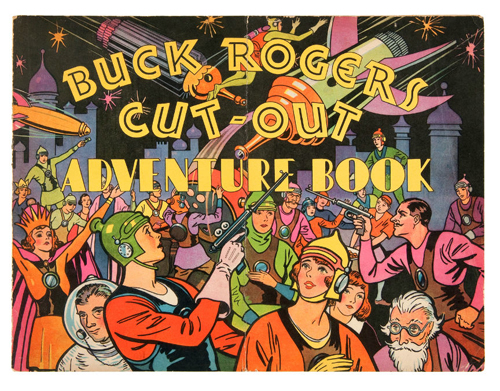Here's a simply delightful Buck Rogers cover, a whimsical and frankly beautiful image of a space filled with colorful planets and even more colorful spaceships flitting through the deep dark. This book seen in some more detail here was an early 1930's Kellogg's cereal premium and apparently is quite the Buck Rogers collectable today. It's charming!
In almost every way measurable by the aesthetics of the art of comics, Buck Rogers, though the first of the hugely successful comic strips, was inferior to the later Flash Gordon. But don't try and tell that to Buck's many fans.

In a nifty book I own called Blast Off! dedicated to the myriad collectibles from decades of sci-fi and outer space comics and TV shows and elsewhere there are thirteen whole pages dedicated the sundry collectibles of Flash Gordon such as ray guns, Big Little Books, and such. But for Buck Rogers the book spends no less than thirty-seven pages documenting just some of the badges, toys, games and such inspired by the characters.

After reading the first few years of the daily strip in the collection The Collected Works of Buck Rogers in the 25th Century, a book I've had in my collection for decades, I am a little tired to be honest. The concepts by the creators come at the reader fast and furiously, something that likely quickened the imaginations of folks coming to these notions for the first time. In two panels of the first daily Buck Rogers is transported to the world of the future and quickly made a soldier of the "Orgs". These are organizations which have replaced states in what was once the continental United States and these "Orgs" are in different states of technological development with some being rather primitive indeed. Buck has wakened to a world dominated by the Mongols.
.jpg)
And that brings up the nastiest aspect of the Buck Rogers story, the rampant racism in the inherent concept. While Flash Gordon dabbles in "Yellow Peril" tropes with the faraway Ming the Merciless, Buck Rogers jumps into the outlandish racist attitude with both anti-gravity levitated feet. It's a race war across the continent and the "white" forces are definitely on the defensive and feeling their long and in their minds deserved hegemony over other races slipping away. (Not at all like the real modern world. Yikes!) A line like that's "white of you" is actually used at one point in the series. Now I don't want to beat this to death, and truth told I felt that after the initial story the story went in some less offensive directions, but there's no getting away from that fundamental fix at first.
Artistically the best I can say for the earliest Buck Rogers strips is that they are cramped, hampered by too much text squeezed into too small panels. There is a static quality to the story telling which gets a little dull after a time, a lack of imagination as to angles and there are no close-ups that I recollect. Knowing what anyone looks like really is a guess at best.
Like much of the early science fiction these strips are less about the people than the technology they use and that explains I guess the fascination with machines and the toys too.
There is, to the strip's credit a strong move to interact with the readership and based on what I've seen of later years of the series the art gets much better and even in color compelling.
NOTE: This is a Dojo Revised Classic Post.
Rip Off







No comments:
Post a Comment